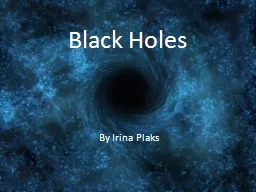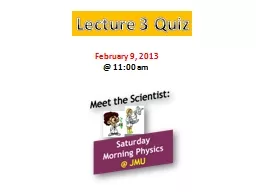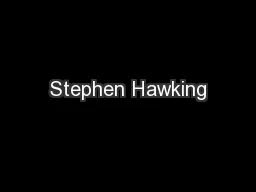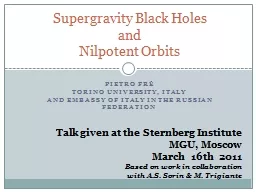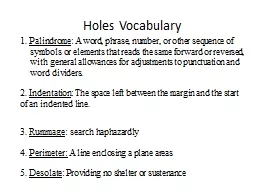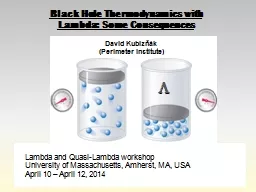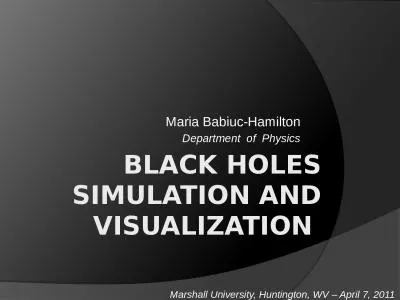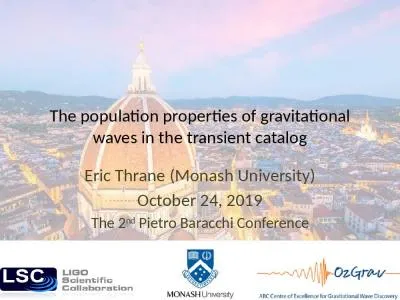PPT-Black Holes - Chapter 21
Author : conchita-marotz | Published Date : 2018-11-01
1 The most massive stellar cores If the core is massive enough 3 M total initial mass of star gt 25 M or so even neutron degeneracy pressure can be overwhelmed
Presentation Embed Code
Download Presentation
Download Presentation The PPT/PDF document "Black Holes - Chapter 21" is the property of its rightful owner. Permission is granted to download and print the materials on this website for personal, non-commercial use only, and to display it on your personal computer provided you do not modify the materials and that you retain all copyright notices contained in the materials. By downloading content from our website, you accept the terms of this agreement.
Black Holes - Chapter 21: Transcript
1 The most massive stellar cores If the core is massive enough 3 M total initial mass of star gt 25 M or so even neutron degeneracy pressure can be overwhelmed by gravity A catastrophic collapse is inevitable gt black hole. And 57375en 57375ere Were None meets the standard for Range of Reading and Level of Text Complexity for grade 8 Its structure pacing and universal appeal make it an appropriate reading choice for reluctant readers 57375e book also o57373ers students Information. . Scramblers. How. . information. . survives. . falling. . into. a black hole. Master thesis Wilke van der Schee. Supervised by prof. Gerard ’t Hooft. August 19, 2010. Introduction. IU Astronomy. Mini-University 2014. Monster Black Holes. What . is a . black . h. ole. ,. anyway?. A black hole is….. …an object whose gravity is so intense that light cannot escape. How Big . By Irina . Plaks. What is a black hole?. . A . black hole is a . region in . spacetime. where . the gravitational field is so strong that . nothing, not even light, can escape it.. Black Holes and the General Theory of Relativity. Thermodynamics with Lambda: Some Consequences. L. David . Kubiz. ňák. (Perimeter Institute). . Lambda and Quasi-Lambda workshop. University of Massachusetts, Amherst, MA, USA. April 10 – April 12, 2014. February 9, 2013. @ 11:00 am. T. he unusually bright centers found in some galaxies are called . a. ctive galactic nuclei.. s. tarbursts.. h. alos.. s. upermassive. black holes.. According to current understanding, what is a quasar?. “godfather of black holes”. . Hawking . has a motor . neurone. disease that is related to amyotrophic lateral sclerosis (ALS), a condition that has progressed over the years. As of 2012, he is almost completely . Fré. Torino . University. , Italy. And . Embassy. . of. ITALY in the . Russian. . Federation. Supergravity. . Black. . Holes. . and . Nilpotent. . Orbits. Talk . given. at the . Sternberg. . 1. . Palindrome. : A word, phrase, number, or other sequence of symbols or elements that reads the same forward or reversed, with general allowances for adjustments to punctuation and word dividers.. L. David . Kubiz. ňák. (Perimeter Institute). . Lambda and Quasi-Lambda workshop. University of Massachusetts, Amherst, MA, USA. April 10 – April 12, 2014. Plan of the talk. Black holes as thermodynamic objects . blue hole. is a submarine cave or underwater sinkhole. They are also called vertical caves. There are many different blue holes located around the world, from Belize and the Bahamas to the Red Sea. Blue holes are roughly circular, steep-walled depressions, and so named for the dramatic contrast between the dark blue, deep waters of their depths and the lighter blue of the shallows around them.. Game: Format: Pro shops draws 9 holes. After game the “blind holes” will be posted Pairings: By flights Scoring: Net score added on these holes only. Post score. Payout: Per individual/pe Maria Babiuc-Hamilton. Department of Physics. Marshall University, Huntington, WV. – April . 7. , . 2011. . The Elusiveness Of Gravity. What is Gravity? Not an attraction force!. Matter distorts the space-time geometry. catalog. Eric Thrane (Monash University). October 24, 2019. The 2. nd. . Pietro. . Baracchi. Conference. Welcome to the era of routine detections!. Thirty-three . new events since the beginning of the third observing run on April 1..
Download Document
Here is the link to download the presentation.
"Black Holes - Chapter 21"The content belongs to its owner. You may download and print it for personal use, without modification, and keep all copyright notices. By downloading, you agree to these terms.
Related Documents




